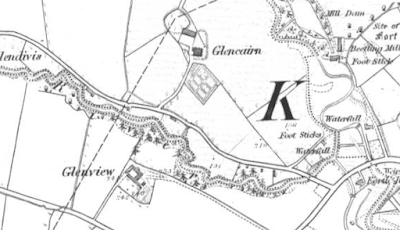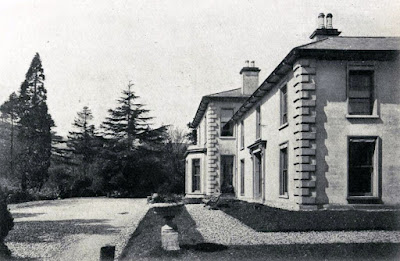THOMAS CUNNINGHAM, of Crookedstone, in the parish of Killead, County Antrim (believed to have been son of Patrick Cunningham, of the same parish, whose will was dated 1696), married Elizabeth ______, and died ca 1728, leaving issue,
Hugh, of Dungonnell, dsp;The younger son,
WILLIAM (Rev), of whom presently;
a daughter, m Hugh Mosman;
a daughter, m Josias Cunningham;
a daughter, m Samuel McMaster;
Ann; Elizabeth.
THE REV WILLIAM CUNNINGHAM, Minister of Limavady, County Londonderry, 1720, wedded Margaret Bradshaw, and dying in 1740, left issue,
Thomas;His third son,
George;
SAMUEL, of whom presently;
Thomas.
SAMUEL CUNNINGHAM (c1697-1789), of Crookedstone and Dungonnell, espoused firstly, in 1727, Mary, daughter of Samuel Thompson, of Muckamore, County Antrim, and had issue,
William, of Ahoghill and Greenhall;He married secondly, __________, widow of Francis Brown; and thirdly, Mary ______.
SAMUEL, of whom presently;
John, of Dungonnell;
Margaret; Sarah; Mary; a daughter.
Mr Cunningham's second son,
SAMUEL CUNNINGHAM (c1742-1812), of Crookedstone, wedded, in 1765, Mary, daughter of John Barber, of British, Killead, and had issue,
Samuel;The youngest son,
John;
William, merchant, of Belfast;
James, of Belmount, Antrim;
Thomas;
Thomas;
Josias, partner with his brother Barber; wholesale tobacco merchants;
BARBER, of whom we treat;
Sarah; Mary; Elizabeth.
BARBER CUNNINGHAM (1787-1841), of Belfast, a partner with his brother Josias in the firm of Josias and Barber Cunningham, espoused, in 1818, Margaret, daughter of David McClure, of Killead, and had issue,
JOSIAS, of whom hereafter;The eldest son,
Samuel;
David McClure;
Agnes McClure; Agnes McClure.
JOSIAS CUNNINGHAM (1819-95), of Glencairn, Belfast, who founded the firm of Josias Cunningham and Company, Stockbrokers, in 1843, married, in 1855, Jane Agnes, daughter of James Davis, solicitor, of Belfast, and had issue,
JAMES (1857-1924), of Glencairn, Stockbroker; died unmarried;The third son,
JOSIAS (1861-1929), of Glencairn, company director; died unmarried;
SAMUEL KNOX (Rt Hon), of whom hereafter;
David (twin), died 1864;
Margaret; Jane Agnes; Emily; Mary Elizabeth; Anna Wise; Sarah Catherine.
THE RT HON SAMUEL CUNNINGHAM (1862-1946), of Fernhill, Belfast, wedded, in 1898, Janet Muir Knox, eldest daughter of Dunlop McCosh, Solicitor, of Dalry, Ayrshire, and had issue,
Josias, stockbroker;The youngest son,
Dunlop McCosh, of 22, Broomhill Pk, Belfast;
James Glencairn, OBE DL;
SAMUEL KNOX, of whom hereafter.
(SAMUEL) KNOX CUNNINGHAM QC (1909-76), Ulster Unionist politician, barrister and business man, was educated at RBAI, Fettes College, Edinburgh, and Clare College, Cambridge, where he was heavy-weight boxing champion.
Mr Cunnungham was engaged in business in Northern Ireland between 1931-37; called to the Bar of Middle Temple, 1939; and the Inn of Court of Northern Ireland, 1942.
He later became a QC.
During the 2nd World War he served with the Scots Guards, and in 1943 and 1945 he unsuccessfully contested the parliamentary seat of Belfast West.
In 1955 he contested and won the parliamentary seat of South Antrim, a seat which he held until his retirement in 1970.
Cunningham's fame rests chiefly on his distinguished parliamentary career.
Between 1958-59 he was PPS to the Financial Secretary to the Treasury; and between 1959-63 held his most important and influential position as PPS to the Prime Minister, Harold Macmillan.
This was a unique position for an Ulster Unionist and for four years Knox Cunningham worked in the centre of power at Westminster.
It was in Mr Macmillan’s 1963 resignation honours list that Knox Cunningham was awarded with a baronetcy, designated of Crookedstone, Killead, County Antrim, for his distinguished services to the Prime Minister.
When the Labour Party came to power under Harold Wilson in 1964, Sir Knox pressed and probed with innumerable questions and interventions in debates and he had many verbal clashes with Harold Wilson himself in the House of Commons.For three years Sir Knox was a member of the United Kingdom Parliamentary Delegation to the Council of Europe and Western European Union at Strasbourg where he put Ulster’s case to the Europeans.
Sir Knox was on the right wing of Ulster Unionism and was a powerful critic of Terence O’Neill’s political reforms in Northern Ireland.
Sir Knox died without issue in 1976, when the title became extinct.
FERNHILL HOUSE was built in the 1860s by John Smith, a wealthy Belfast butter
merchant.
The site had to be cut out of the rock-face.
It comprises two storeys, a mixture of Classical and Italian Renaissance style, with a fine Greek-style portico.
In 1898, Fernhill was acquired by Samuel Cunningham, a member of a leading family involved in the grain and tobacco trade.
The Cunninghams owned about 133 acres of land in the Shankill and Ballygomartin areas of Belfast.
Cunningham was a stockbroker, chairman of the Northern Whig and a leading member of the Ulster Unionist Council and the Ulster Provisional Government from 1911 onwards.
The original Ulster Volunteer Force of 1912-14 drilled in these grounds before the 1st World War.
The stables at Fernhill were always stocked with the finest race horses: Tipperary Tim was winner of the 1928 Grand National.
In October, 1994, the Loyalist ceasefire was proclaimed at Fernhill House.
The site had to be cut out of the rock-face.
It comprises two storeys, a mixture of Classical and Italian Renaissance style, with a fine Greek-style portico.
In 1898, Fernhill was acquired by Samuel Cunningham, a member of a leading family involved in the grain and tobacco trade.
The Cunninghams owned about 133 acres of land in the Shankill and Ballygomartin areas of Belfast.
Cunningham was a stockbroker, chairman of the Northern Whig and a leading member of the Ulster Unionist Council and the Ulster Provisional Government from 1911 onwards.
The original Ulster Volunteer Force of 1912-14 drilled in these grounds before the 1st World War.
The stables at Fernhill were always stocked with the finest race horses: Tipperary Tim was winner of the 1928 Grand National.
In October, 1994, the Loyalist ceasefire was proclaimed at Fernhill House.
 |
| Glencairn ca 1860 (historic OS map) |
THE GLENCAIRN ESTATE originally covered more than 100 acres of land at the bottom of Divis Mountain.
It included four houses - Glencairn and Fernhill, which stood on either side of a sloping valley, Glendivis, situated between the Ballygomartin River and Glencairn Road (just beyond the present entrance to the park), and Four Winds, located further along the Glencairn Road.
The largest houses, Glencairn and Fernhill, were also served by modest mid-19th century gate lodges.
In 1899, Samuel Cummingham moved into Fernhill House, which had great views of Belfast, the Mourne Mountains and even the family's home country of Scotland.
The Cunningham family eventually moved to Glencairn House and lived on the estate for most of the 20th century.
Glencairn and Fernhill were surrounded by extensive lawns, gravel pathways, mature trees, formal gardens, vegetable plots, a croquet lawn, shrub borders and a rock garden.
An ancient rath or fort, around 120 feet in diameter with ramparts and a surrounding trench, was located behind Fernhill House.
The trench was filled in and used as a ring for training horses while the Cunninghams lived on the estate. Both Glencairn and Fernhill Houses were damaged during the 2nd World War.
When Colonel Cunningham returned home after the war, he found Glencairn House empty and abandoned and his family living in part of Fernhill House.
The estate was eventually acquired by the Belfast Corporation (now the council) in 1962 and re-opened as a public park.
Parkview Care Home, a sprawling two-storey building, now occupies the site of Glencairn.
 |
| Glencairn House (Image: Richard Graham) |
BY THE LATE 18th and early 19th century, the Cunninghams had clearly established themselves as merchants and businessmen.
Samuel’s brothers John, William, James, Thomas, Josias and Barber, were all directly involved in business and commerce.
John Cunningham (of Glenwood, a house which is roughly in the same location as the present day Glenwood Primary School) and Thomas Cunningham were partners in the firm of J & T Cunningham at Mill Street, Belfast.
 |
| Glencairn (Image: Richard Graham) |
James Cunningham was a grain merchant; William was a merchant at Belfast; Josias and Barber (the youngest brothers) were partners in a firm of wholesale tobacco importers based at Rosemary Street, Belfast.
Barber Cunningham, a tobacco merchant, was the father of Sir Josias Cunningham DL, one of the most well-known members of this family.
Sir Josias firmly established the family’s fortunes.
First Published in June, 2010. I am grateful to Richard Graham for use of images of Glencairn.





6 comments :
Whatever happened to Glencairn House ? I have been to Fernhill, however, scant details is available..
Is glencairn house the one beside the river with the bars on its windows?
Glencairn house was knocked down an parkview nursing home now stands in its place .. it was just across from fernhill house
Fernhill has been left empty for many years.
Which Cunningham was the first president of the Belfast Chamber of Commerce, late 1780s or 90s?
Was it Waddell Cunningham who was the first president.
Post a Comment